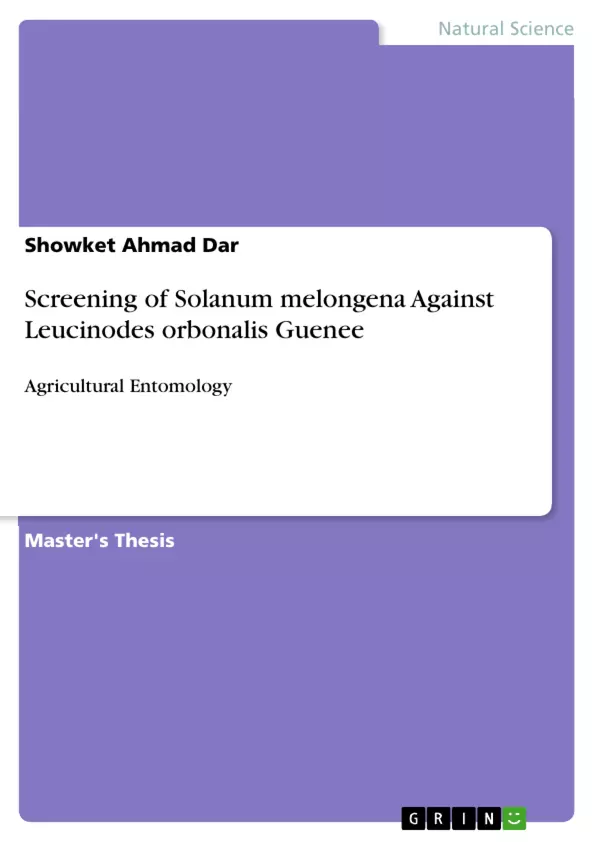The present investigations were carried out to screen some important varieties/genotypes of brinjal against Leucinodes orbonalis under field conditions and also to determine morphological, biochemical characteristics of brinjal showing some degree of tolerance against this pest. All 12 varieties/genotypes as treatment were raised in Randomized Block Design with 3 replications. The relative susceptibility of the various brinjal genotypes to Leucinodes orbonalis infestation was ascertained by recording number, weight of infested and uninfested fruits.
Relative susceptibility of shoots was done by recording number of damaged/undamaged shoots from each entry up to harvest time and percentage calculated. Observations in respect of several morphological characters including fruit length, fruit diameter, shape and volume index, length of peripheral seed ring, ratio of length of peripheral seed ring, length of seed less area, ratio of length of seed less area, pericarp thickness, shoot/leaf hairs, yield per plant, number of fruits per plant, plant height, number of branches per plant, roughness/smoothness of calyx, flower and fruit colour and biochemical characters including total phenols, total sugars, moisture and ash were assayed.
Correlation between borer infestation with morphological and biochemical characters was also determined. All genotypes screened revealed that none of them were immune to the infestation of L.orbonalis. On the basis of level of infestation on number basis genotypes were grouped as: 2 resistant genotypes (Brinjal-85 and Local long); 2 fairly resistant (Shalimar Brinjal purple Round-8 and Shalimar Brinjal purple Round-1); 5 tolerant (Shalimar Brinjal purple Long-42, Shalimar Brinjal purple Long-208, Shalimar Brinjal Long-217, Dilruba-2 and Brinjal purple Long); 2 susceptible (Brinjal oblong, Shalimar Brinjal Hybrid-2) and one highly susceptible (Shalimar Brinjal Hybrid-1) while as, on weight basis one resistant, 2 fairly resistant, 4 tolerant, 3 susceptible and 2 highly susceptible.
Five genotypes were recorded resistant and 7 as fairly resistant on the basis of mean percent shoot infestation. Shalimar Brinjal Hybrid-1(highly susceptible) and Shalimar Brinjal Hybrid-2 (susceptible) recorded the maximum fruit infestation of 23.07, 20.00 and 22.50, 21.75 per cent on number and weight basis, respectively. While as, Brinjal-85 and Local Long (resistant) genotypes suffered minimum fruit damage
Frequently asked questions
What is this language preview about?
This is a comprehensive language preview which includes the title, table of contents, objectives and key themes, chapter summaries, and key words for a research document likely related to the study of brinjal crop resistance to pests.
What are the objectives of the study?
The study objectives include: 1) Studying the incidence and severity of important brinjal varieties/genotypes against shoot and fruit borer under field conditions. 2) Determining the morphological/biochemical characteristics responsible for exhibiting resistance to brinjal shoot and fruit borer (L. orbonalis) by screening various varieties.
What key themes are analyzed?
The key themes revolve around host plant resistance in brinjal, focusing on morphological and biochemical factors influencing resistance to Leucinodes orbonalis (shoot and fruit borer). It explores the correlation between plant characteristics, infestation levels, and identifies resistant and susceptible genotypes.
What morphological characteristics are considered?
The document discusses morphological characters like fruit length, fruit diameter, shape index, volume index, peripheral seed ring length, ratio of the seed ring length, length of seedless area, ratio of length of seedless area, pericarp thickness, shoot and leaf hairs, plant height, number of branches per plant, roughness/smoothness of calyx, and flower and fruit colour.
What biochemical parameters are analyzed?
The study analyzes biochemical parameters including total phenols, total sugars, moisture content, and ash content in relation to borer infestation.
What statistical methods are used?
Data is analyzed using Analysis of Variance (ANOVA) and simple correlation to determine relationships between plant characteristics and pest infestation.
What does the literature review cover?
The literature review focuses on studies related to the incidence and severity of brinjal varieties/genotypes against shoot and fruit borer under field conditions, and the determination of morphological and biochemical characteristics of brinjal varieties/genotypes exhibiting some degree of tolerance against the brinjal shoot and fruit borer (Leucinodes orbonalis Guenee).
What are some of the key words associated with the research?
The key words include Brinjal, Screening, Shoot borer, Fruit borer, Incidence, Morphology, and Biochemical parameters.
Which genotypes are highlighted in the summary?
Specifically mentioned are Brinjal-85 and Local Long (resistant), Shalimar Brinjal Hybrid-1 and Shalimar Brinjal Hybrid-2 (susceptible), as well as several other genotypes classified as tolerant or fairly resistant.
What are the research findings?
Findings indicate that no brinjal genotype is completely immune to L. orbonalis. Variations in morphological and biochemical characteristics influence susceptibility, with resistant genotypes generally exhibiting traits like higher phenol content and lower sugar content. Infestation is positively correlated with fruit diameter and length of seedless area and negatively correlated with ratio of seedless length and shoot hairs and leaf hairs
- Quote paper
- Showket Ahmad Dar (Author), 2012, Screening of Solanum melongena Against Leucinodes orbonalis Guenee, Munich, GRIN Verlag, https://www.grin.com/document/353822



